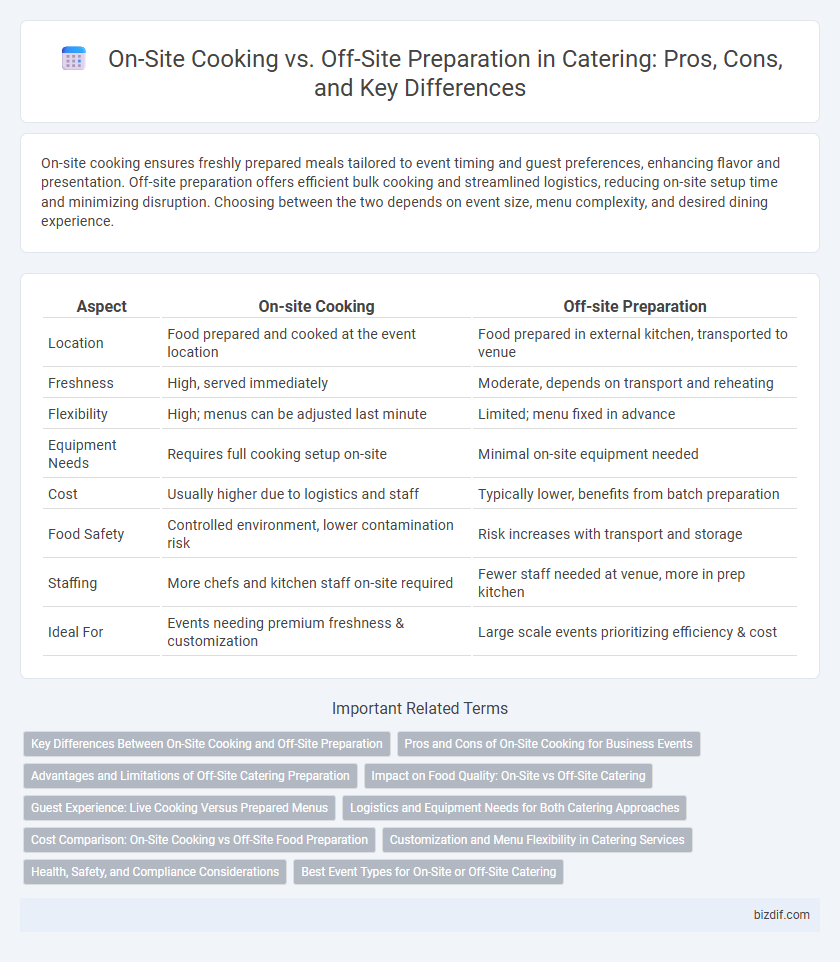On-site cooking ensures freshly prepared meals tailored to event timing and guest preferences, enhancing flavor and presentation. Off-site preparation offers efficient bulk cooking and streamlined logistics, reducing on-site setup time and minimizing disruption. Choosing between the two depends on event size, menu complexity, and desired dining experience.
Table of Comparison
| Aspect | On-site Cooking | Off-site Preparation |
|---|---|---|
| Location | Food prepared and cooked at the event location | Food prepared in external kitchen, transported to venue |
| Freshness | High, served immediately | Moderate, depends on transport and reheating |
| Flexibility | High; menus can be adjusted last minute | Limited; menu fixed in advance |
| Equipment Needs | Requires full cooking setup on-site | Minimal on-site equipment needed |
| Cost | Usually higher due to logistics and staff | Typically lower, benefits from batch preparation |
| Food Safety | Controlled environment, lower contamination risk | Risk increases with transport and storage |
| Staffing | More chefs and kitchen staff on-site required | Fewer staff needed at venue, more in prep kitchen |
| Ideal For | Events needing premium freshness & customization | Large scale events prioritizing efficiency & cost |
Key Differences Between On-Site Cooking and Off-Site Preparation
On-site cooking involves preparing meals directly at the event location, ensuring freshly cooked dishes and an interactive dining experience, while off-site preparation entails cooking in a separate commercial kitchen with meals transported to the venue, which allows for better control of food safety and efficiency. Key differences include freshness and customization options favoring on-site cooking, whereas off-site preparation excels in scalability and logistical convenience. Both methods require careful planning, but on-site cooking demands more staff and equipment at the venue, contrasting with the streamlined setup of off-site catering services.
Pros and Cons of On-Site Cooking for Business Events
On-site cooking at business events offers the advantage of freshly prepared meals, enhancing flavor and presentation, while allowing customization to guest preferences. It requires skilled chefs, specialized equipment, and often higher costs, presenting logistical challenges compared to off-site preparation. However, the interactive and sensory experience of on-site cooking can elevate event atmosphere, making it ideal for high-profile or personalized gatherings.
Advantages and Limitations of Off-Site Catering Preparation
Off-site catering preparation allows for efficient bulk cooking in a controlled environment, minimizing disruptions at the event location and ensuring consistent food quality. This method reduces the need for extensive kitchen setup on-site, lowering labor costs and logistical complexities. However, off-site preparation may face challenges such as limited menu customization, potential delays in food transport, and reduced freshness compared to on-site cooking.
Impact on Food Quality: On-Site vs Off-Site Catering
On-site cooking preserves food freshness by allowing precise temperature control and immediate serving, which enhances flavor and texture. Off-site preparation risks quality degradation during transportation and reheating, often leading to moisture loss and diminished taste. Choosing on-site catering ensures superior food quality through real-time cooking and plating.
Guest Experience: Live Cooking Versus Prepared Menus
On-site cooking enhances guest experience by offering interactive, fresh meal preparation that engages diners and elevates event ambiance. Live cooking stations allow for customization and real-time visual appeal, creating memorable moments and a dynamic atmosphere. Off-site preparation with pre-plated menus ensures consistency and efficiency but lacks the personalized engagement that live culinary demonstrations provide.
Logistics and Equipment Needs for Both Catering Approaches
On-site cooking requires extensive kitchen equipment, including portable ovens, burners, and refrigeration units, demanding more space and power sources at the event location. Off-site preparation minimizes on-site equipment needs but increases logistics complexity with insulated transport containers and chilled vehicles to maintain food safety and temperature control during transit. Both approaches necessitate careful planning for staff coordination, timely delivery, and compliance with health regulations to ensure efficient service and high-quality food presentation.
Cost Comparison: On-Site Cooking vs Off-Site Food Preparation
On-site cooking typically incurs higher labor and equipment costs due to the need for skilled chefs and kitchen setup at the event location, while off-site food preparation benefits from centralized kitchen efficiency and bulk purchasing, reducing per-unit expenses. Off-site preparation also minimizes the risk of food waste and equipment rental fees, contributing to overall cost savings. However, on-site cooking allows for fresher meals and customization, which can justify higher expenses depending on event requirements.
Customization and Menu Flexibility in Catering Services
On-site cooking enables greater customization and menu flexibility by allowing chefs to prepare dishes fresh, adjust ingredients in real-time, and accommodate last-minute dietary requests. Off-site preparation typically involves set menus and pre-planned dishes, limiting the ability to tailor options during the event. Catering services offering on-site cooking often deliver a more personalized dining experience that enhances guest satisfaction.
Health, Safety, and Compliance Considerations
On-site cooking allows for real-time monitoring of food safety protocols, reducing risks of contamination and ensuring compliance with health regulations. Off-site preparation requires stringent packaging and transportation standards to maintain temperature control and prevent cross-contamination during delivery. Both methods must adhere to local health codes, but on-site cooking often provides greater flexibility in managing allergen controls and immediate sanitization practices.
Best Event Types for On-Site or Off-Site Catering
On-site cooking excels at events requiring fresh, customizable meals such as weddings, corporate retreats, and cooking demonstrations, where guest interaction and food presentation are priorities. Off-site preparation is ideal for large-scale events like conferences, banquets, or festivals that demand efficient mass catering and timely food delivery. Selecting between on-site and off-site catering depends on factors like event size, menu complexity, and the need for immediate food freshness.
On-site cooking vs Off-site preparation Infographic

 bizdif.com
bizdif.com